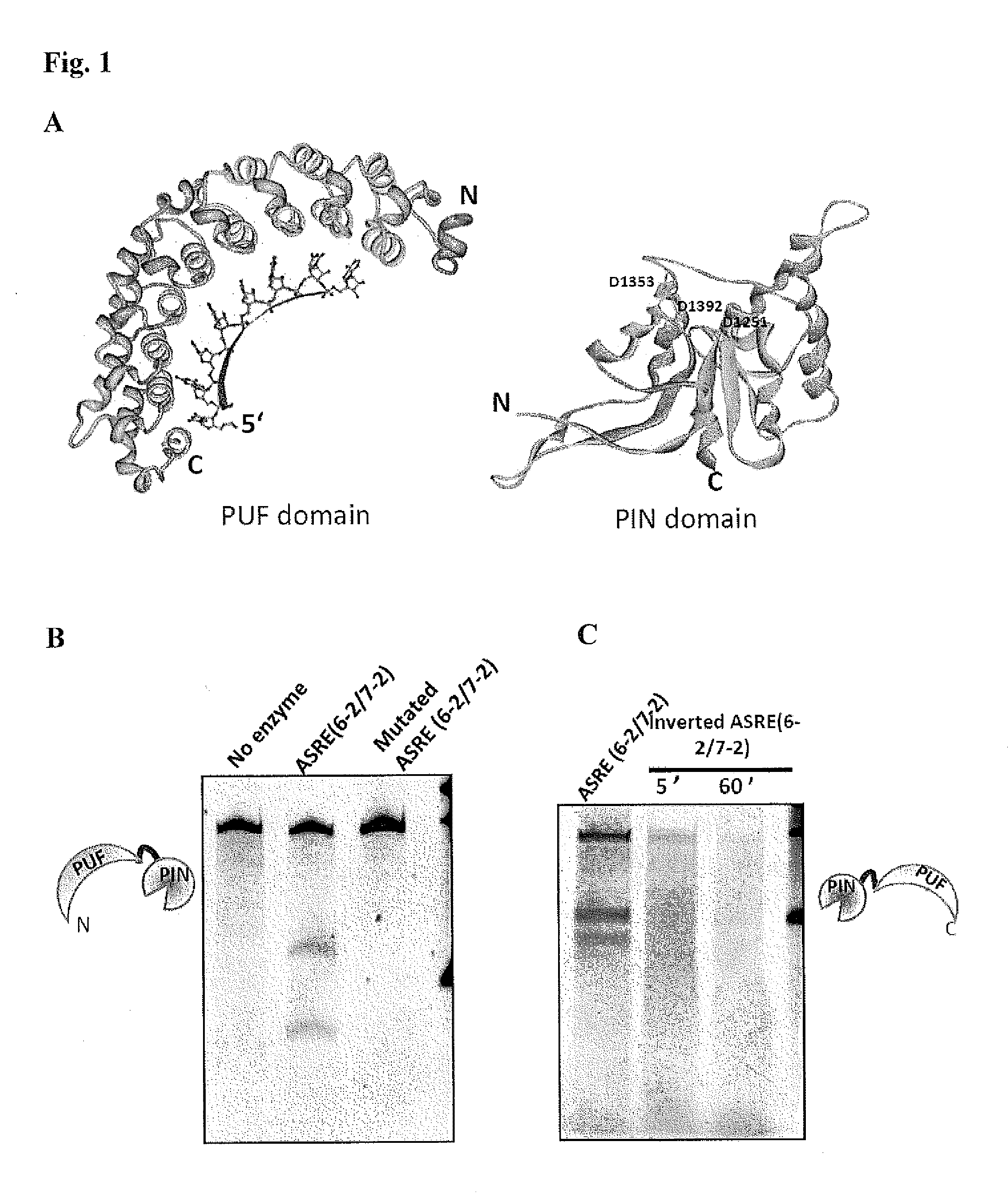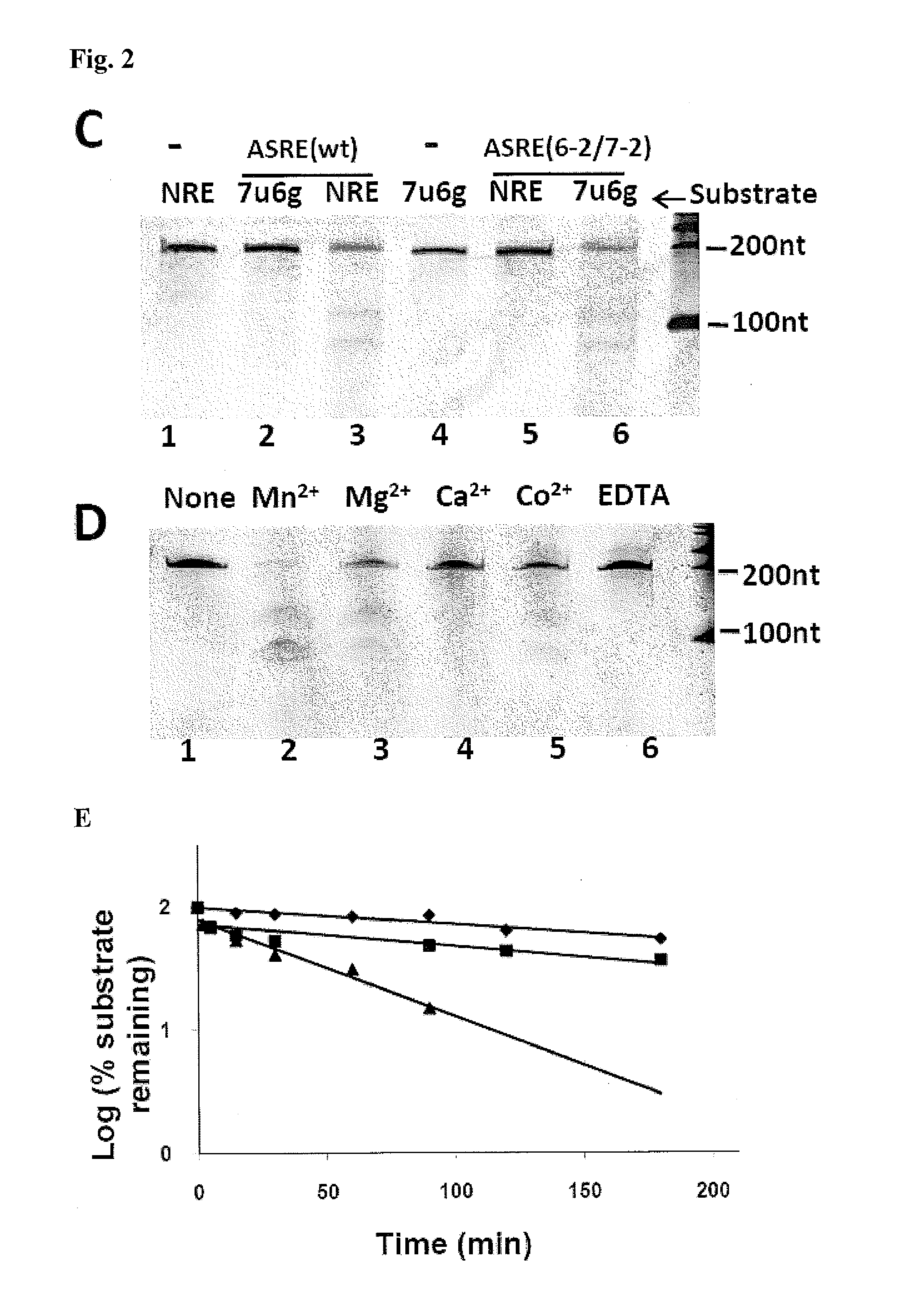Methods and Compositions for Sequence Specific RNA Endonucleases
a technology of rna endonuclease and sequence specificity, which is applied in the direction of fusion with rna-binding domain, peptide/protein ingredient, instruments, etc., can solve the problems of low turnover rate of nucleic acid enzymes, high production cost, and in vitro application of such nucleic acid enzymes
- Summary
- Abstract
- Description
- Claims
- Application Information
AI Technical Summary
Benefits of technology
Problems solved by technology
Method used
Image
Examples
example 1
REFERENCES FOR EXAMPLE 1
[0148]1. O. Takeuchi and S. Akira, Immunol Rev 227 (1), 75 (2009).[0149]2. D. P. Bartel, Cell 136 (2), 215 (2009).[0150]3. S. J. Baker, J. L. Morris, and I. L. Gibbins, Brain Res Mol Brain Res 111 (1-2), 136 (2003).[0151]4. I. J. MacRae and J. A. Doudna, Curr Opin Struct Biol 17 (1), 138 (2007).[0152]5. J. J. Champoux and S. J. Schultz, FEBS J 276 (6), 1506 (2009).[0153]6. W. G. Scott, Curr Opin Struct Biol 17 (3), 280 (2007).[0154]7. H. Yoshida, Methods Enzymol 341, 28 (2001).[0155]8. Y. Tomari and P. D. Zamore, Genes Dev 19 (5), 517 (2005).[0156]9. T. W. Nilsen, Bioessays 25 (12), 1147 (2003).[0157]10. S. K. Silverman, Nucleic Acids Res 33 (19), 6151 (2005).[0158]11. M. Wickens, D. S. Bernstein, J. Kimble et al., Trends Genet. 18 (3), 150 (2002).[0159]12. S. D. Auweter, F. C. Oberstrass, and F. H. Allain, Nucleic Acids Res 34 (17), 4943 (2006).[0160]13. X. Wang, J. McLachlan, P. D. Zamore et al., Cell 110 (4), 501 (2002).[0161]14. C. G. Cheong and T. M. Hal...
example 2
[0175]In addition to being the organelle in energy production for eukaryotic cells, the mitochondrion plays a critical role in myriad cellular processes such as control of apoptosis and ROS (reactive oxygen species) signaling. Thus mitochondria dysfunction is linked to various diseases such as cancer, autism and age-associated neurodegenerative diseases. Most mitochondrial proteins are coded by nuclear DNA and imported into mitochondria after translation. Mitochondria have a distinct genome, and the human mitochondrial genome contains 13 protein-coding, 2 rRNA, and 22 tRNA genes (FIG. 21A). Although mitochondrial gene mutations are closely linked to various diseases, the functions of these genes are hard to study because there are limited research tools to manipulate mitochondrial gene expression. A new ASRE with a mitochondrial targeting signal has been generated that can be used to specifically silence mitochondrial gene expression by cleaving mitochondrial RNA, making it possible...
example 3
REFERENCES FOR EXAMPLE 3
[0233]1. Lee J E, Cooper T A. Pathogenic mechanisms of myotonic dystrophy. Biochem Soc Trans. 2009; 37(Pt 6):1281-6.[0234]2. Turner C, Hilton-Jones D. The myotonic dystrophies: diagnosis and management. J Neurol Neurosurg Psychiatry. 2010; 81(4):358-67.[0235]3. Wheeler T M, Thornton C A. Myotonic dystrophy: RNA-mediated muscle disease. Curr Opin Neurol. 2007; 20(5):572-6.[0236]4. Mahadevan M, Tsilfidis C, Sabourin L, Shutter G, Amemiya C, Jansen G, et al. Myotonic dystrophy mutation: an unstable CTG repeat in the 3′ untranslated region of the gene. Science. 1992; 255(5049):1253-5.[0237]5. Brook J D, McCurrach M E, Harley H G, Buckler A J, Church D, Aburatani H, et al. Molecular basis of myotonic dystrophy: expansion of a trinucleotide (CTG) repeat at the 3′ end of a transcript encoding a protein kinase family member. Cell. 1992; 68(4):799-808.[0238]6. Liguori C L, Ricker K, Moseley M L, Jacobsen J F, Kress W, Naylor S L, et al. Myotonic dystrophy type 2 cause...
PUM
| Property | Measurement | Unit |
|---|---|---|
| molar ratio | aaaaa | aaaaa |
| molar ratio | aaaaa | aaaaa |
| pH | aaaaa | aaaaa |
Abstract
Description
Claims
Application Information
 Login to View More
Login to View More - R&D
- Intellectual Property
- Life Sciences
- Materials
- Tech Scout
- Unparalleled Data Quality
- Higher Quality Content
- 60% Fewer Hallucinations
Browse by: Latest US Patents, China's latest patents, Technical Efficacy Thesaurus, Application Domain, Technology Topic, Popular Technical Reports.
© 2025 PatSnap. All rights reserved.Legal|Privacy policy|Modern Slavery Act Transparency Statement|Sitemap|About US| Contact US: help@patsnap.com



